How To Make A Money Crown Step By Step
It's that time of year once more, fellow homesteaders… tree tapping fourth dimension! No maple trees on your homestead? No problem, at that place are more than one dozen other trees common to the Usa that can also exist tapped for syrup and sugar.
Typically, trees are prime for tapping between the middle of Feb through mid-March. The verbal time to offset and stop borer trees for maple syrup depends largely on where you live. The sap from maple and most other tappable trees begins to flow when the temperature during the daytime is consistently to a higher place freezing, and when evening temperatures still hover at or beneath 32 degrees.
The maple tree tapping flavor more often than not runs for approximately four to six weeks. The sweetest and best sap is commonly produced during the early days and weeks of the flavor. It is the combination of the dank night time temperatures and the warm daytime temperatures that causes the sap to period both easily and fairly chop-chop, from the trees.
Best Maple Trees to Tap for Syrup
Hard maple tree varieties like the black, rocky, and sugar maple, typically produce the highest sap content. Maple trees with a lower sap content, like the silver or red varieties, typically take longer to bring to a eddy – a crucial part of the syrup cosmos procedure.
• Blackness – This maple tree more often than not offers the highest product of sap each flavor. The sugar content of the Black Maple tree is approximately two per centum. The sap turned into syrup from this tree is typically deemed just as sweet as the sap created past the Sugar Maple tree – and there is usually about twice as much of it.
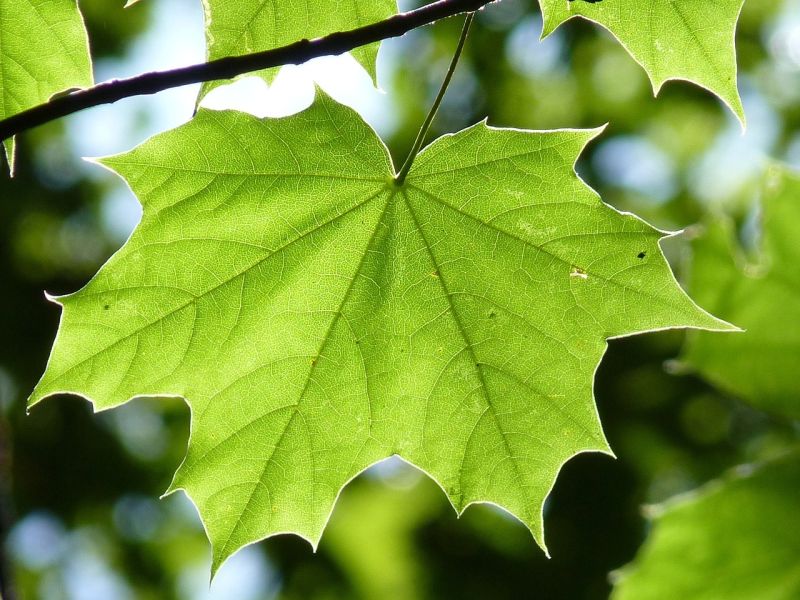
to a higher place photograph shows a sugar maple tree leafage
• Sugar – This is the "get to" tree for tapping. The Saccharide Maple grows in significant numbers in USDA zones 4 through viii. The sugar and syrup produced from this variety is incredibly sweet and succulent.
• Big Foliage – These maple trees are routinely found growing abundantly from California all the way up to British Columbia. Native American tribes who lived in this region often tapped the Big Leaf Maple tree for syrup and sugar making purposes. This variety of maple tree does non produce as much sap every bit the Carbohydrate Maple, but is often considered just equally sweet.
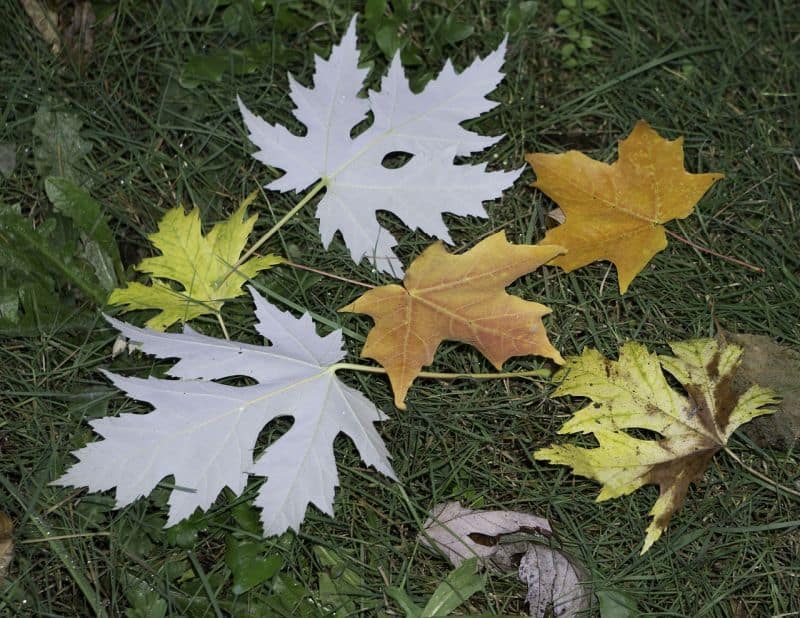
above photo shows silvery maple tree leaves
• Silvery – Although non ideal for tapping, the Silver Maple tree tin can exist tapped. Typically, this variety of maple tree will accept a more watery or thinner sap and a low sugar content. Buds begin to appear on the Silvery Maple tree early in the year, before prime borer temperatures present and sustain themselves, in many regions.
• Big Tooth Maple – This sap producing maple tree grows primarily in the Rocky Mountains region and in Texas. The sweetness of the syrup produced from this tree is comparable to that of a Sugar Maple tree, fifty-fifty though it is churned out in less abundance.
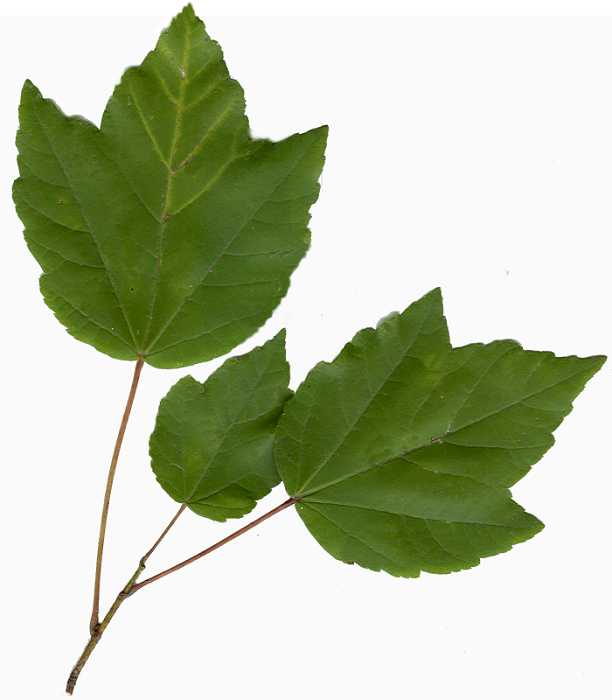
above photograph shows a red maple tree leaf
• Cherry – Sap from this maple tree contains about a 1.7% sugar content. While the syrup is very tasty, the Red Maple tree creates less sap than either the Black or the Sugar Maple tree varieties.
• Rocky Mount Maple – This tree grows in the region which bears its name. The Plateau Native American tribes often tapped the Rocky Mountain Maple tree for carbohydrate and syrup.
The trees selected should be fully mature and mensurate a minimum of 12 inches in diameter – and of form, good for you. The trees, maple and otherwise, that have average to above average sunlight exposure commonly produce the most sap. A stiff and healthy tree can be tapped multiple times over several seasons.
How to Identify a Maple Tree
If you have not taken a hike around your homestead and mapped out all the types of maple trees you lot have on hand to tap, pull on your boots and do so quickly, before the prime function of tapping flavour has passed.
Maple trees have what we dubbed "helicopters" when growing up. The seedlings growing on them not only resemble the propellers of a helicopter, but "wing" away from the tree and start to grow merely near everywhere they country. Hard maple varieties begin letting loose of their seeds ordinarily in either the late summer or early autumn. Soft maple varieties tend to drop their seeds in either the early on days of summertime, or the last weeks of spring.
The leaves from hard maple copse are normally night green with smooth points. In the autumn, you probably ooh and aah at the cute cerise, orange, and yellowish shades the leaves from these trees plow each October.
Leaves from soft maple copse are ordinarily a lite greenish or yellow-green color. Their leaves are either silver or white on the bottom, and boast a more pointy shape than the leaves from hard maple tree varieties.
Hard maple tree leaves frequently appear to boast a "U" shape, and soft maple tree leaves have a shape than looks more like a "5" shape.
The bawl on hard maple tree varieties is typically filled with deep and narrow furrows. Information technology has bawl that is night greyness in colour.
The bark on soft maple tree varieties feature bark that can all-time exist described as flaky, and comprised of layers in a lighter shade of grayness, usually.
Non-Maple Trees to Tap for Sugar and Syrup
• Sycamore – Sap from this tree has a yummy butterscotch flavour. The Sycamore sap yield is usually a lot less than virtually every version of maple tree.
• Black Walnut – This tree produces not only succulent nuts, but a tasty sap as well. You can ordinarily tap the Black Walnut tree in every season except the summertime.
• English Walnut – If y'all have purchased walnuts to bake with or but to munch upon from your local grocery store, they probably came from this diversity of tree. Sap will catamenia from this tree only when evening temperatures are firmly below the freezing level for at to the lowest degree one calendar week.
• White Walnut – Sap from the White Walnut (or Butternut Tree) contains the aforementioned high percentage of carbohydrate as the Carbohydrate Maple tree. The corporeality of sap that flows from this variety of walnut tree is also often comparable to the yield from the Sugar Maple tree.
• Newspaper Birch – This type of birch tree has a 1% carbohydrate count and is amidst a favorite for tappers who expand their efforts beyond the maple multifariousness. The European, black, river, gray, white, and yellow birch copse tin can as well exist tapped, but the sap they each produce is not generally virtually as sweet as the sap that flows from the Paper Birch tree.
Tree Tapping Tips and Preparations
When the tree existence tapped is between xx to 27 inches in diameter, you may need to use two taps to capture all of the sap. For huge trees above 27 inches in bore, utilise three taps when collecting sap. Using a single tap could overtax the tree and could affect its health.
More often than not, a unmarried tree tin be tapped up to three times before y'all accept to move on to another one.
If the tree has a big "crown" or lots of full and sturdy branches in its mid-section, it might be a slap-up sap producer.
Tree Tapping Equipment
Always make clean the tree tapping equipment when you put it away after a flavour and earlier borer during a new flavor. Many tappers use a mixture of 1-part bleach (unscented) to twenty parts h2o to clean their equipment. Scrub the equipment with a house brush and rinse, at least 2 to three times, with very hot water and let them to air dry fully before storage or apply.
• Spouts – some tappers and stores refer to the spouts every bit spiles.
• Buckets or Bags – Traditional tappers use buckets that can be hung on or to a higher place the spout and onto the tree to collect sap. Bags manufactured specifically for tree borer are gaining popularity with some tappers because they are lightweight and easier to pack when full or during hikes that are either lengthy or over rugged terrain… or both. Tapping buckets must take a house fitting lid.
• Holder or Hooks – Holders are sold to hang either buckets or bags and purchased by some tree tappers. Many tappers only make their ain simple hooks to hang the sap collection buckets or bags upon or use a spout that comes with a hook fastened for the bucket.
• Sap Hydrometer – These optional gadgets are handy to have if you are interested in learning the saccharide content in your sap before cooking it.
• Filtering Fabric – Yous tin buy sap filters, but cheesecloth will do the trick just fine.
Yous tin can also become pre-made tree sapping kits on Amazon.
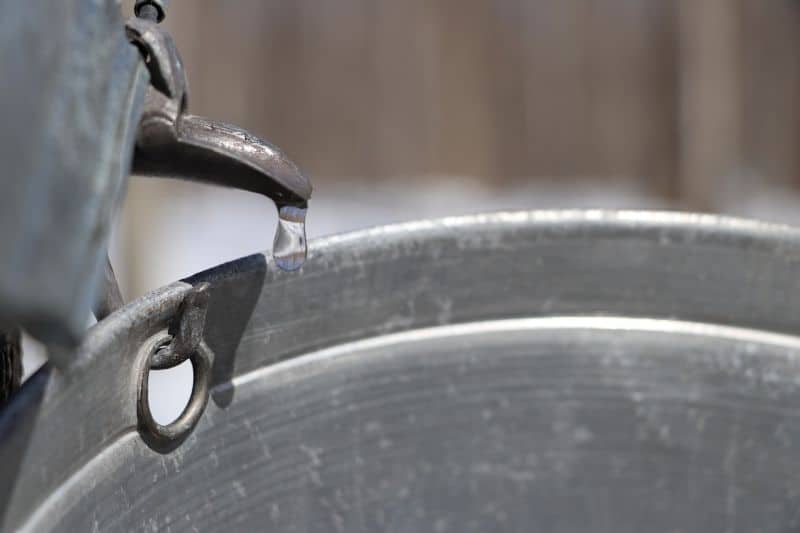
How to Tap a Tree For Syrup
one. Identify the tapping hole at to the lowest degree 3 feet from the lesser of the tree. If the tree has been tapped before, make sure you do non locate the pigsty inside 6 inches from the prior sap collection spot.
It is best to distribute the tapping holes around the tree's circumference when putting in a new season holes or making multiple tapping holes on a big tree for the first fourth dimension. Most tappers recommend drilling the tapping pigsty on the southern facing side of the tree, beneath a big co-operative.
2. Drill the tapping hole. The dimensions of the drill bit will depend both on the size of the tree and the spout beingness used to collect sap. Typically, a 7/16 or 5/16 drill bit will work for about spouts and trees. The hole drilled should be between 2 to 2.5 inches deep.
3. Inspect the shaving churned out while drilling the borer pigsty. If it's calorie-free brown or beige, the tree is most likely healthy and you lot have selected a skilful spot to garner sap. If the tree shavings have a dark brownish hue, yous accept probably discovered a bad spot in the tree and demand to locate the sap drove pigsty in some other location on the same tree. If you hit night brown again, it may not be worth your time and effort to endeavor to tap the tree.
4. Insert the spout after cleaning out the drilled pigsty of all shaving. Refer to the directions that came with your particular spout or spiles to make sure information technology is positioned properly. The claw on the spout should be facing outward.
5. Employ a hammer or rubber mallet to tap, gently now, the spout into the concur to secure information technology into identify. If you have chosen the right time to tap, the sap from the tree should begin to flow, at least slightly, from the tree immediately after the spout has been affixed.
half dozen. Hang your bucket or pocketbook on the tree – this is commonly done by hanging it onto the hook facing outward on the spout, but not all spouts and spiles come with a claw. You could use whatsoever bucket you want, but the ones made specifically for tapping take a hole on their rims for the hook to slide through. If you utilise a bucket non manufactured for tapping trees, brand certain information technology is a clean food-form container that is capable of holding five gallons of sap.
7. Attach the hat to the bucket and spout/spile every bit indicated by the directions on your specific equipment.
The equipment you will demand to tap near 10 trees should not cost your about than $50, depending upon the prices at the local or online shop y'all shop. In my personal experience, the 5-gallon buckets with lids sold at farm and garden stores like Tractor Supply or Rural Rex work only fine for tapping trees.
Sap Collection Tips
• If this is your first time tapping a tree for syrup, practice non be startled by the color of the fluid running out of the tree. It volition be a clear liquid that does not look all that much unlike from h2o.
• Apply tree tapping pouches like the ones in the photo beneath to go on debris and other impurities away from your sap.
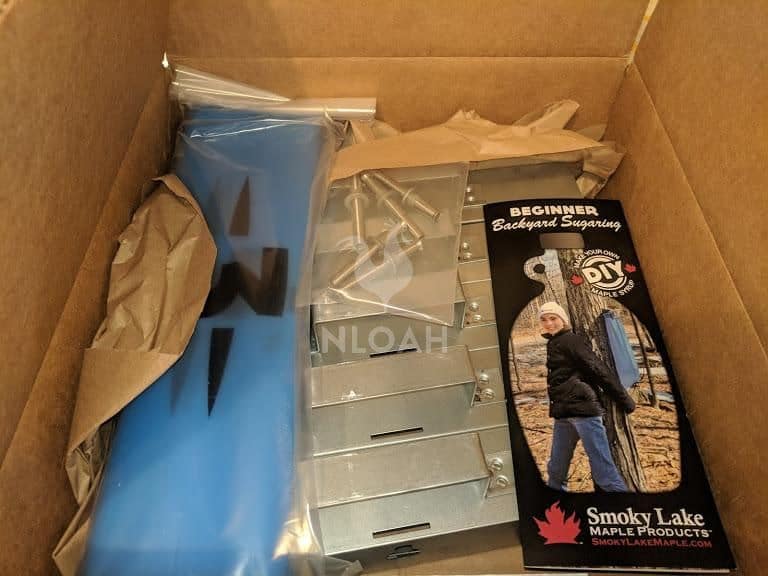
• The amount of sap you lot go far your buckets in a single day will vary based upon fluctuations in temperature. Some days, your buckets might exist virtually inundation when you hike out to check them, but other days you lot might find simply a very small amount of sap in the lesser of the bucket or handbag.
• Tree tapping is a lot of work. You have to check the buckets and collect the sap daily – no thing how busy you are or what the conditions is similar outdoors. You lot might be hiking out to your trees upwardly to your ankles in mud with pelting pouring heavily upon your shoulders, but the sap buckets must exist check and poured into a storage container. If you delay and let the sap sit in a saucepan overnight it will likely freeze and have to exist pitched. Wasting time is definitely not something homesteaders like to do!
• Strain the nerveless sap through the cheesecloth or manufactured filter to remove any debris that might accept gotten inside the bucket earlier putting it in a storage container.
• The sap must exist stored at a temperature of 38F or colder for best results.
• For best results, use or process the sap inside 1 week of drove.
• Some folks dear to drink the sap correct after it flows from the tree, this is not recommended! For the safest type of consumption, e'er boil the sap to destroy any bad bacteria that could be growing inside. To boil sap, bring it to a full and rolling boil, and hold information technology in that location for well-nigh one minute, earlier turning off the rut.
Although syrup is the nigh common use for sap, in some regions of the earth it is brewed into beer or tea and consumed for its nutrient benefits.
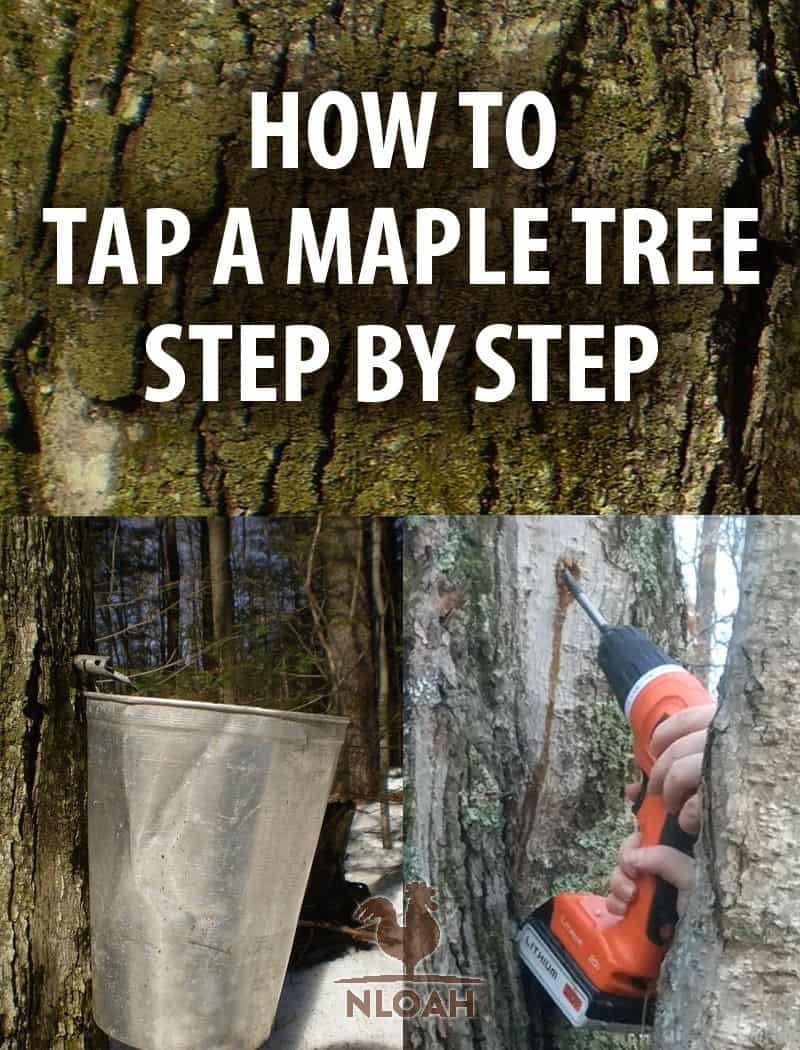
Source: https://www.newlifeonahomestead.com/how-to-tap-a-maple-tree/
Posted by: allenclas1974.blogspot.com

0 Response to "How To Make A Money Crown Step By Step"
Post a Comment